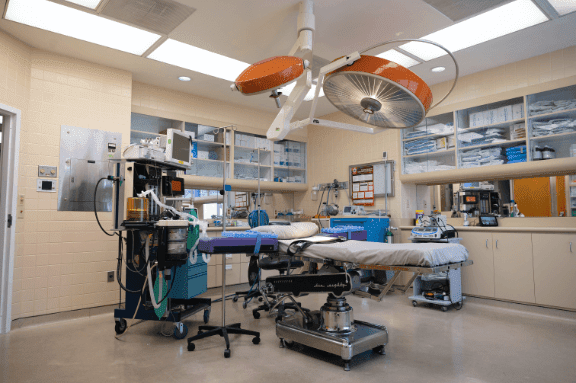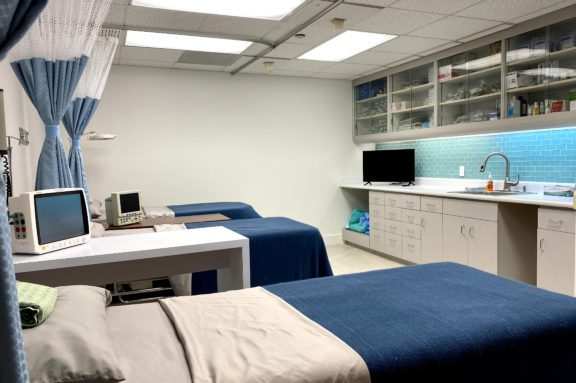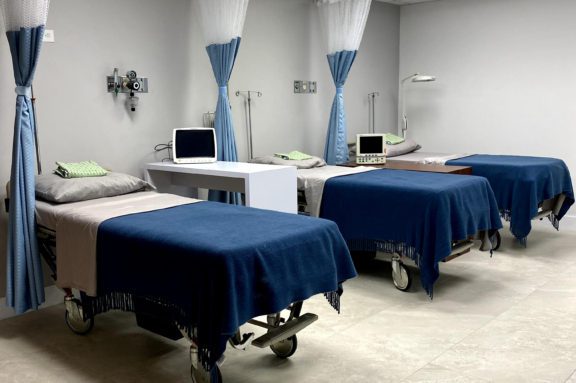Transfeminine Bottom Surgery
For transgender women who are on a journey to becoming the person they are meant to be, transfeminine bottom surgery may be the next step.
At Restore Medical Center, we offer several bottom surgery options. Our board-certified surgeon Dr. John L. Whitehead has years of experience performing gender reassignment surgery and expertly performs each procedure to help our patients achieve bodies that better align with their true gender identity. While the physical impact is significant, we are truly inspired and humbled to partner with our patients to see and assist in the emotional benefits they experience, building their self-confidence and discovering newfound comfort throughout their transformation journey.
What Is Transfeminine Bottom Surgery?
Transfeminine bottom surgery—also referred to as male-to-female (MTF) bottom surgery—refers to the different surgical methods for the feminization of the masculine genitals and lower body. These gender-affirming procedures are designed to help trans women take control of their bodies and feel more comfortable in their daily lives.
Am I a Candidate for Transfeminine Bottom Surgery?
According to the World Professional Association for Transgender Health (WPATH) Guidelines for Genital Gender-Affirming Surgieris, candidates for transfeminine bottom surgery should meet the following criteria:
- 18 years or older (exceptions may be made on a case-by-case basis)
- Persistent and well-documented gender dysphoria
- Capacity to make a fully informed decision and consent to treatment
- Cleared for gender reassignment surgery by two licensed therapists who specialize in gender transition
- Any significant or chronic medical concerns are well controlled
- 12 continuous months of hormone therapy
- 12 continuous months of living in a gender role congruent with their gender identity
Patients should also be nonsmokers in good overall health who have a support system of family, friends, or trusted adults to help assist them through surgery and recovery. For more information on readiness for the procedure, read our blog on the top five steps to know if you’re ready for transfeminine bottom surgery.
Please Explain Bottom Surgery
We would love to speak about your transfeminine (MTF) bottom surgery options with you during a private one-on-one consultation at our Miami area practice. As advocates in the LGBTQ+ community, it is our passion to help each trans man or woman achieve their true selves through beautifully personalized results and board certified expertise. Please feel free to contact our office online, or call us at 305.865.2000.
Our On-Site Fully Accredited Surgery Center
Our surgical suite makes surgery much more affordable and
private than doing the procedure in the hospital.




What Techniques Are Used for Transfeminine Bottom Surgery?
At Restore Medical Center, we understand that each patient’s journey is as unique as they are. That’s why we offer a range of options for your transfeminine bottom surgery, depending on your personal goals. Dr. Whitehead will create a surgical plan unique to your individual needs and desires, ensuring the most natural and true-to-you results.
What Is Orchiectomy?
Orchiectomy is surgery that removes the testicles, resulting in sterility as well as a loss of testosterone. A simple or scrotal orchiectomy, which uses an incision made in the scrotum, is most commonly performed for transfeminine bottom surgery. Orchiectomy is performed at the time of full genital reassignment surgery. However, some people may like to do orchiectomy as its own procedure, either because they don’t plan to go on to have further reassignment surgery or because they want some type of surgical treatment for dysphoria when full reassignment surgery may be in the future.
Given the emotional benefits that trans women experience as a result of the removal of the testicles, some of our transfeminine bottom surgery patients choose to undergo just an orchiectomy. Some people may wish to do this before full genital reassignment surgery. However, others may prefer to undergo a vaginoplasty to achieve a more feminine appearance and functionality of their genitals.
What Is Vaginoplasty?
Vaginoplasty is a gender-affirming surgery that transforms the male genitals into a beautifully feminine and functional vulva and vagina. When performed by the skilled and meticulous Dr. Whitehead—who has extensive experience performing transfeminine surgeries—patients can expect complete functionality when urinating and having sexual intercourse.
The vaginal canal is created to allow penetrative intercourse, usually through a penile-inversion technique. A scrotal skin graft may be used to augment the length of the penile tube. The anterior vagina is created from mucosal tissue and is thus self-lubricating. The urethra is shortened and re-oriented so that the urinary stream will be directed into the toilet bowl when seated. A clitoris is constructed to be sensate, able to be stimulated, and facilitate orgasm. Labia majora and minora are created to give a feminine appearance.
A vaginoplasty is designed to be a one-stage procedure when performed by Dr. Whitehead at Restore Medical Center. Patients can have an orchiectomy before the procedure or at the same time.
What Is Zero-Depth Vaginoplasty?
Zero-depth vaginoplasty is similar to vaginoplasty but without creating a vaginal canal. To outward appearances, a patient’s genitalia will appear alike, whether a traditional vaginoplasty or zero-depth vaginoplasty has been performed. Someone might prefer this procedure to traditional vaginoplasty for several personal reasons—she might not want to dilate postoperatively, she may not want to have penetrative sex, or she may wish to avoid possible complications associated with traditional vaginoplasty, among other reasons.
How Do I Prepare for My Transfeminine Bottom Surgery?
At Restore Medical Center, our top priority is YOU. We are committed to providing comprehensive support and guidance throughout your gender reassignment journey. Our goal is to ensure you have all the information and details necessary to make a well-informed decision about your surgeries, and we will work closely with you to create the best plan for your unique situation.
During your private one-on-one consultation, you can ask any and all questions about transfeminine bottom surgery. Dr. Whitehead and all the staff at Restore Medical Center are sensitive and understanding and will work closely with you to create the best plan for your unique situation.
Following the WPATH Guidelines, we require that each patient meets with two licensed mental health professionals to ensure surgery is an appropriate treatment for their dysphoria. Restore Medical will work with you to help facilitate these meetings so that you may get to surgery sooner rather than later to help alleviate your gender dysphoria.
Our surgery team, led by Dr. Whitehead, is dedicated to providing you with comprehensive support. We will give you detailed pre-surgical instructions in the weeks and days following your procedure. These instructions will cover everything from preparing for your surgery to your postoperative care and recovery. If you have any questions or concerns regarding your surgery at any time, please do not hesitate to call our office directly. We are here for you every step of the way.
How Is Transfeminine Bottom Surgery Performed?
Anesthesia
Your surgery will be performed under general anesthesia with the highest safety and professional standards at our on-site QUAD A (formerly AAAASF) accredited surgery center. Dr. Whitehead works with our on-site board-certified anesthesiologist, Dr. Alain Ramirez. Our entire team is dedicated to ensuring your safety and providing the best possible surgical outcome. You can rest assured that you are in good hands.
You must have a friend, partner, or family member available to drive you to and from your appointment and provide care and assistance during your initial recovery. Some surgeries are outpatient, but an overnight hospital stay may be necessary.
Orchiectomy Surgery
During a simple or scrotal orchiectomy, an incision will be made in the scrotum. Dr. Whitehead will then remove the testicles and parts of the spermatic cord through this incision. Once removed, incisions are closed and covered with surgical dressings.
Vaginoplasty Surgery
There are different methods for vaginoplasty surgery and accompanying procedures like labiaplasty and clitoroplasty. During your initial consultation, Dr. Whitehead will detail the steps of your specific procedure so you understand what to expect and have decided on your preferred outcome.
Penile inversion vaginoplasty, often referred to as the “‘gold standard”‘ in transfeminine bottom surgery, is most often performed as a single-stage procedure that incorporates orchiectomy, partial penectomy, and penile dissection with the creation of the vaginal cavity, labiaplasty, and clitoroplasty.
Once the surgery is completed, all incisions are closed and covered with surgical dressings.
VIEW PHOTO GALLERY
Our gallery contains medical photos that are not suitable for visitors under the age of 18.

What Is My Initial Recovery Like After Transfeminine Bottom Surgery?
Transfeminine bottom surgery patients usually spend the first night after surgery in our facility, tended to by an attending physician and registered nurse. The morning after surgery, your assistant for the week (often a family member or friend) will take you to a prearranged hotel via car. You will be able to walk short distances on your own.
You will relax and heal in a local hotel a block from Restore Medical for the next week. Dr. Whitehead will visit you in the hotel to ensure that recovery progresses safely and without complications. One week after surgery, you will come back to Restore for removal of dressings and instructions regarding vaginal dilating. In most cases, you are then cleared to travel back home.
You will experience some swelling, bruising, and discomfort after your surgery. However, these are expected side effects and will resolve independently as your body’s natural healing process is given time to function.
Dr. Whitehead will provide you with detailed postoperative instructions. Because each patient is unique, postoperative instructions are tailored to both the patient and the specific surgery performed.
The physical and emotional benefits of transfeminine bottom surgery are incredibly life-changing. Transfeminine bottom surgery is a significant surgery with permanent results. All patients considering transfeminine bottom surgery must be fully prepared and aware of the risks and benefits.
Are There Complications or Risks Involved in Transfeminine Bottom Surgery?
Like any surgery, complications after transfeminine bottom surgery can occur, including:
- Bleeding
- Infection
- Hematoma
- Loss of sensation
There are several risks associated with transfeminine bottom surgery. Certain vaginoplasty patients may also experience suture separation or urine retention, while orchiectomy patients may experience inguinal hernia. Other possible complications include changes in the urine stream or a heightened risk of urethral infection. Serious complications are rare but may consist of tissue necrosis, rectal injuries, fistulas, deep vein thrombosis, and pulmonary embolism. Please contact our practice and Dr. Whitehead immediately if you have any questions or concerns after your surgery.
Learn More About Transfeminine Bottom Surgery in Florida
If you are considering transfeminine bottom surgery, it’s time to schedule an appointment with the experts at Restore Medical Center. Dr. Whitehead and all our medical staff are highly trained and experienced in gender reassignment surgery. Just as importantly, they are compassionate, kind, and understanding, making each patient feel seen and cared for when they’re most vulnerable. Call us today at 305.865.2000 to schedule your consultation or complete our online contact form.
We look forward to partnering with you on your transformation journey.

FAQ About Transfeminine Bottom Surgery
Will I need hair removal before my transfeminine bottom surgery?
If you are undergoing a vaginoplasty, it is recommended to undergo permanent hair removal, typically on your scrotum and skin on the lower part of your penis. You should begin hair removal as soon as possible, as it often takes 3–6 months to complete. While Dr. Whitehead does perform follicle-scraping at the time of surgery, this combined approach has not led to any patients having hair growth from the vaginal canal.
Permanent hair removal is not necessary for orchiectomy or zero-depth vaginoplasty patients.
What should I have on hand to make my recovery after transfeminine vaginoplasty surgery more comfortable?
Dr. Whitehead will provide you with a list of things to help make recovery from your vaginoplasty more comfortable, which may include:
- Pain medications
- Compression garments
- Ice packs
- Donut cushion
- Baby wipes
- Maxi pads
- Douche bottle and peri bottle
- Lubricating jelly
Ensuring that you are well-prepared and equipped for recovery before surgery will make your return home for recovery go much more smoothly. Have a plan for meals, housekeeping, and entertainment options to keep you healthy and feeling positive on your transformation journey.
How long does transfeminine bottom surgery take?
Most vaginoplasty surgeries take about five hours to complete, while orchiectomy surgery takes around an hour.
When can I return to work after transfeminine bottom surgery?
Returning to work and other everyday activities depends on how extensive your surgery was. Orchiectomy patients can typically return to work after 2–3 weeks. Vaginoplasty patients have a significantly more extended healing period, with most returning to work and other daily activities 6–8 weeks after surgery.
When will I be able to resume having sex after transfeminine bottom surgery?
Transfeminine vaginoplasty patients must wait to have sex for at least 12 weeks following surgery to allow for complete healing of all incisions and avoid any post-surgical complications.
Orchiectomy and zero-depth vaginoplasty patients will need to wait at least 3–4 weeks before resuming sexual activities.
Can I stop hormone treatment after surgery?
Hormone treatment will continue to be necessary for life; however, your doses will likely be modified. Dosages will be calculated depending on hormone levels after surgery and your age. Please ensure any hormone medication changes you make are done under the supervision of your endocrinologist.
Next Steps? We’d Love to Speak with You One-on-One
Our goal is for you to feel fully informed so you can make the best decision for you. Contact us for a virtual or in-person consultation and start the your life-changing conversation.
